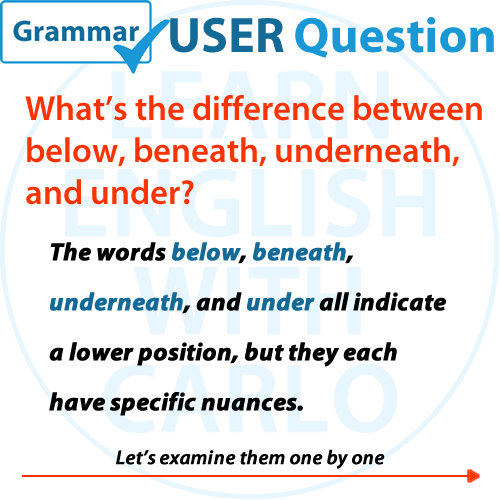
The English language often offers several words to convey similar meanings, each with subtle distinctions that can add depth to our communication. Words like below, beneath, underneath, and under all suggest a lower position, but each carries its unique nuance. In this post, we’ll explore these differences with clear definitions, examples, and usage tips.
1. Below
Definition: “Below” generally refers to something at a lower level, often without direct contact. It’s commonly used for abstract or comparative ideas, such as measurements, levels, or ranks, where something is positioned at a lower point than a reference.
Usage: Use “below” for general positions that aren’t physically touching. You’ll often encounter it in discussions about height, temperature, or rank.
Examples:
- “The airplane flew below the clouds.” (No direct contact; the plane is at a lower altitude.)
- “Temperatures dipped below freezing last night.” (Used to describe an abstract level.)
- “He is ranked below her in the company hierarchy.” (Used to describe a lower level in terms of rank.)
2. Beneath
Definition: “Beneath” is often similar to “below” but has a slightly more formal or old-fashioned tone. It can imply something directly underneath, often adding a sense of depth, hierarchy, or even something hidden. Sometimes it conveys a metaphorical meaning, as in situations involving respect or worth.
Usage: Use “beneath” in more formal contexts, or when you want to convey a sense of depth or hidden position. It’s also useful in abstract contexts, especially those involving status or worth.
Examples:
- “The treasure was buried beneath the ancient oak tree.” (Physical depth and placement directly under.)
- “She felt that task was beneath her abilities.” (Implies a metaphorical hierarchy or sense of worth.)
- “Beneath the cheerful façade, he was actually very worried.” (Suggests something hidden, figuratively beneath the surface.)
3. Underneath
Definition: “Underneath” suggests being covered or concealed by something, typically physical objects. It’s similar to “under” but often emphasizes a sense of being hidden or out of view.
Usage: Use “underneath” when you want to highlight that something is obscured or covered by another object, adding an element of concealment.
Examples:
- “The keys were underneath the newspaper.” (Implying the keys are hidden from view by the newspaper.)
- “They found shelter underneath a rocky ledge during the storm.” (The ledge provides cover or concealment.)
- “She had a hidden compartment underneath her desk for important documents.” (Emphasizes hidden or secret placement.)
4. Under
Definition: “Under” is the most general term for indicating a lower position and is commonly used in everyday speech. It usually describes something directly beneath or covered by something else.
Usage: Use “under” for direct, concrete relationships, especially in physical locations or situations where one thing is directly below another.
Examples:
- “The cat is hiding under the table.” (Physical location directly below the table.)
- “He stored the boxes under the bed.” (Physical placement directly beneath the bed.)
- “They found a cool spot under the tree.” (A concrete location directly below the tree’s canopy.)
Additional Tips for Choosing the Right Word
Understanding these differences can help you choose the right word based on your context. Here’s a quick guide:
- General positioning with no direct contact: Use below.
- “The shelf is just below the ceiling.”
- A formal, metaphorical, or hidden sense: Opt for beneath.
- “He believed that kind of behavior was beneath him.”
- Emphasis on being covered or concealed: Choose underneath.
- “Her journal was tucked away underneath a pile of blankets.”
- For straightforward, physical locations or conditions: Go with under.
- “The puppy is resting under the chair.”
Summary
By mastering the subtle distinctions between “below,” “beneath,” “underneath,” and “under,” you can improve the clarity and richness of your language. Whether you’re describing an object’s position, expressing an abstract idea, or using figurative language, selecting the right term can help your meaning shine through.
